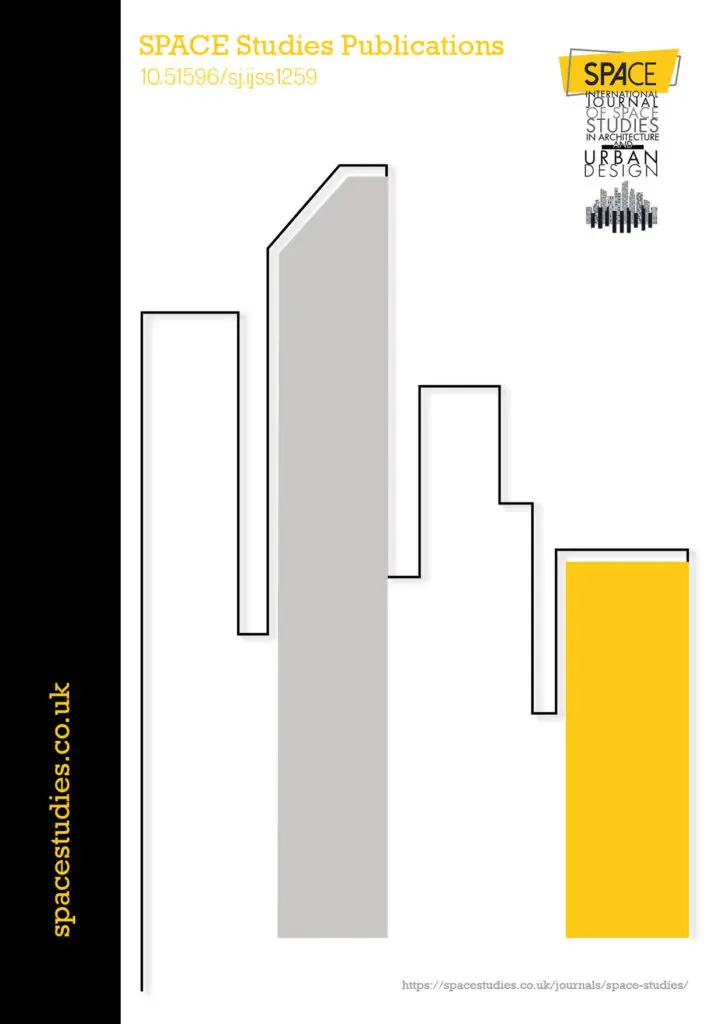
In this study, cool island (CI) potentials as urban parks and green spaces of Antalya where it is in the Mediterranean climate belt were investigated by handling together with their peripheries’ urban morphology. Surface temperature data were obtained by remote sensing methods using Landsat 8 satellite images. In the study where the GIS techniques were used, the relationships between the cool islands and their surrounding urban texture were analyzed by statistical methods. The results indicate that while the density of adult trees in urban green spaces increases the cooling capacities and cooling distances of green spaces, the morphological characteristics of the peripheries of green spaces change their cooling distances. It is thought that these findings are constituted an important basis for the development of the climate-sensitive urban planning and urban design approach.
£450.00 per Year.
Access to conference registration
Access to Journal subscription
£380.00 per Year.
Access to conference registration. Proof of student eligibility required.
Access to Journal subscription.
£410.00 per Year.
Discounts on conference registrations, SPACE shop and e-journals. Access to members only areas on the website.
Access to Journal subscription.
£400.00 per Year.
Student priced discounts on conference registrations, SPACE shop and e-journals. Access to members only areas on the website. Proof of student eligibility required.
Access to Journal subscription.
Aram, F., García, E. H., Solgi, E., & Mansournia, S. (2019). Urban green space cooling effect in cities. Heliyon, 5(4), e01339. https://doi.org/10.1016/j.heliyon.2019.e01339
Aygün, A., & Torlak, S.E. Denizli İli’nin İklim Değişikliğine Karşı Dayanıklılığının İncelenmesi (An Examinat, on Climate Change Resilience on Denizli). Niğde Ömer Halisdemir Üniversitesi Mühendislik Bilimleri Dergisi, 9(1), 648-664. https://doi.org/10.28948/ngumuh.629809
Barriopedro, D., Fischer, E. M., Luterbacher, J., Trigo, R. M., & García-Herrera, R. (2011). The hot summer of 2010: redrawing the temperature record map of Europe. Science, 332(6026), 220-224. DOI: 10.1126/science.1201224
Bernard, J., Rodler, A., Morille, B., & Zhang, X. (2018). How to design a park and its surrounding urban morphology to optimize the spreading of cool air?. Climate, 6(1), 10. https://doi.org/10.3390/cli6010010
Byrne, J., & Jinjun, Y. (2009). Can urban greenspace combat climate change? Towards a subtropical cities research agenda. Australian Planner, 46(4), 36-43. https://doi.org/10.1080/07293682.2009.10753420
Cao, X., Onishi, A., Chen, J., & Imura, H. (2010). Quantifying the cool island intensity of urban parks using ASTER and IKONOS data. Landscape and urban planning, 96(4), 224-231. https://doi.org/10.1016/j.landurbplan.2010.03.008
Carvalho, D., Martins, H., Marta-Almeida, M., Rocha, A., & Borrego, C. J. U. C. (2017). Urban resilience to future urban heat waves under a climate change scenario: A case study for Porto urban area (Portugal). Urban Climate, 19, 1-27. https://doi.org/10.1016/j.uclim.2016.11.005
ÇINAR, H. S., & ERDOĞAN, R. (2019). Geleneksel bahçe ve mimari üslubun ortaya çıkışında doğal faktörlerin rolü: İran örneği (The Role of Natural Factors in the Emergence of Traditional Garden and Architectural Style: The Case of Iran). Bartın Orman Fakültesi Dergisi, 21(3), 685-699. https://doi.org/10.24011/barofd.583185
Du, H., Cai, W., Xu, Y., Wang, Z., Wang, Y., & Cai, Y. (2017). Quantifying the cool island effects of urban green spaces using remote sensing Data. Urban Forestry & Urban Greening, 27, 24-31. https://doi.org/10.1016/j.ufug.2017.06.008
Doick, K. J., Peace, A., & Hutchings, T. R. (2014). The role of one large greenspace in mitigating London’s nocturnal urban heat island. Science of the total environment, 493, 662-671. https://doi.org/10.1016/j.scitotenv.2014.06.048
Ellison, D., Morris, C. E., Locatelli, B., Sheil, D., Cohen, J., Murdiyarso, D., … & Sullivan, C. A. (2017). Trees, forests and water: Cool insights for a hot world. Global Environmental Change, 43, 51-61. https://doi.org/10.1016/j.gloenvcha.2017.01.002
Feyisa, G. L., Dons, K., & Meilby, H. (2014). Efficiency of parks in mitigating urban heat island effect: An example from Addis Ababa. Landscape and urban planning, 123, 87-95. https://doi.org/10.1016/j.landurbplan.2013.12.008
Gargiulo, C., Tulisi, A., & Zucaro, F. (2016). Small green areas for energy saving: effects on different urban settlements. http://doi.org/10.5821/ace.11.32.4659
Grilo, F.; Pinho, P.; Aleixo, C.; Catita, C.; Silva, P.; Lopes, N.; Freitas, C.; Santos-Reis, M.; McPhearson, T.; Branquinho, C. (2020). Using green to cool the grey: Modelling the cooling effect of green spaces with a high spatial resolution. Science of The Total Environment, 724, 138182, https://doi.org/10.1016/j.scitotenv.2020.138182
Hamada, S., & Ohta, T. (2010). Seasonal variations in the cooling effect of urban green areas on surrounding urban areas. Urban forestry & urban greening, 9(1), 15-24. https://doi.org/10.1016/j.ufug.2009.10.002
Honjo, T., & Takakura, T. (1990). Simulation of thermal effects of urban green areas on their surrounding areas. Energy and buildings, 15(3-4), 443-446. https://doi.org/10.1016/0378-7788(90)90019-F
Jaganmohan, M.; Knapp, S.; Buchmann, C.M.; Schwarz, N. (2016). The Bigger, the Better? The Influence of Urban Green Space Design on Cooling Effects for Residential Areas. Journal of Environment Quality, 45(1), 134-145. https://doi.org/10.2134/jeq2015.01.0062
Jáuregui, E. (1990). Influence of a large urban park on temperature and convective precipitation in a tropical city. Energy and buildings, 15(3-4), 457-463. https://doi.org/10.1016/0378-7788(90)90021-A
Jiménez-Muñoz, J. C., Cristóbal, J., Sobrino, J. A., Sòria, G., Ninyerola, M., & Pons, X. (2008). Revision of the single-channel algorithm for land surface temperature retrieval from Landsat thermal-infrared data. IEEE Transactions on geoscience and remote sensing, 47(1), 339-349. https://doi.org/10.1109/TGRS.2008.2007125
Kuşçu Şimşek, Ç., (2020). İstanbul’un mezo ve mikro iklimsel değişiminin kuzey ormanları ve kent içi yeşil alanlarla ilişkisi (The Relationship of Istanbul’s Meso and Microclimatic Change with Northern Forests and Urban Green Areas) Şu esrede: Ünal Akkemik (Ed.). Ekosistem, İklim ve Kentsel Büyüme Perspektifinden İstanbul ve Kuzey Ormanları. Türkiye Ormancılar Derneği Tayın No:
50, Marmara Şubesi Yayın No:4, İstanbul. ISBN: 978-975-93478-7-1. S:96-109.
MacDonald, J., (2007). How Cities Use Parks for Climate Change Management. American Planning Association (APA), Washington. https://www.planning.org/publications/document/9148693/ Date of access: 10.05.2021
Masoudi, M., & Tan, P. Y. (2019). Multi-year comparison of the effects of spatial pattern of urban green spaces on urban land surface temperature. Landscape and Urban Planning, 184, 44-58. https://doi.org/10.1016/j.landurbplan.2018.10.023
Masuda, Y., Ikeda, N., Seno, T., Takahashi, N., & Ojima, T. (2005). A basic study on utilization of the cooling effect of sea breeze in waterfront areas along Tokyo Bay. Journal of Asian Architecture and Building Engineering, 4(2), 483-487. https://doi.org/10.3130/jaabe.4.483
Matzarakis, A., Rutz, F., Chen, Y., Fröhlich, D. (2017). RayMan Pro, A Tool for Applied Climatology, Rayman Manual Version 0.1. https://www.urbanclimate.net/rayman/RayManManual.pdf
McCarthy, M. P., Best, M. J., & Betts, R. A. (2010). Climate change in cities due to global warming and urban effects. Geophysical research letters, 37(9). https://doi.org/10.1029/2010GL042845
Moss, J. L., Doick, K. J., Smith, S., & Shahrestani, M. (2019). Influence of evaporative cooling by urban forests on cooling demand in cities. Urban Forestry & Urban Greening, 37, 65-73. https://doi.org/10.1016/j.ufug.2018.07.023
Naeem, S., Cao, C., Qazi, W. A., Zamani, M., Wei, C., Acharya, B. K., & Rehman, A. U. (2018). Studying the association between green space characteristics and land surface temperature for sustainable urban environments: An analysis of Beijing and Islamabad. ISPRS International Journal of Geo-Information, 7(2), 38. https://doi.org/10.3390/ijgi7020038
Newman, P. (2020). Cool planning: How urban planning can mainstream responses to climate change. Cities, 103, 102651. https://doi.org/10.1016/j.cities.2020.102651
Otto, F. E., Massey, N., van Oldenborgh, G. J., Jones, R. G., & Allen, M. R. (2012). Reconciling two approaches to attribution of the 2010 Russian heat wave. Geophysical Research Letters, 39(4). https://doi.org/10.1029/2011GL050422
OVALI, P. K. BİYOKLİMATİK TASARIM MATRİSİ (TÜRKİYE) (BIOCLIMATIC DESIGN MATRIX (TURKEY)). Trakya Üniversitesi Mühendislik Bilimleri Dergisi, 20(2), 51-66.
Qiu, K., & Jia, B. (2020). The roles of landscape both inside the park and the surroundings in park cooling effect. Sustainable Cities and Society, 52, 101864. https://doi.org/10.1016/j.scs.2019.101864
Rall, L., Niemela, J., Pauleit, S., Pintar, M., Lafortezza, R., Santos, A., … & Železnikar, Š. (2015). A typology of urban green spaces, eco-system services provisioning services and demands. Report D3, 1.
Ren, Z., He, X., Pu, R., & Zheng, H. (2018). The impact of urban forest structure and its spatial location on urban cool island intensity. Urban Ecosystems, 21(5), 863-874. https://doi.org/10.1007/s11252-018-0776-4
Robine, J. M., Cheung, S. L. K., Le Roy, S., Van Oyen, H., Griffiths, C., Michel, J. P., & Herrmann, F. R. (2008). Death toll exceeded 70,000 in Europe during the summer of 2003. Comptes rendus biologies, 331(2), 171-178. https://doi.org/10.1016/j.crvi.2007.12.001
Sharifi, A. (2021). Co-benefits and synergies between urban climate change mitigation and adaptation measures: A literature review. Science of The Total Environment, 750, 141642, https://doi.org/10.1016/j.scitotenv.2020.141642
Shih, W. Y., Ahmad, S., Chen, Y. C., Lin, T. P., & Mabon, L. (2020). Spatial relationship between land development pattern and intra-urban thermal variations in Taipei. Sustainable Cities and Society, 62, 102415. https://doi.org/10.1016/j.scs.2020.102415
Sobrino, J. A., Jiménez-Muñoz, J. C., Sòria, G., Romaguera, M., Guanter, L., Moreno, J., … & Martínez, P. (2008). Land surface emissivity retrieval from different VNIR and TIR sensors. IEEE transactions on geoscience and remote sensing, 46(2), 316-327. https://doi.org/10.1109/TGRS.2007.904834
Stewart, I. D., & Oke, T. R. (2012). Local climate zones for urban temperature studies. Bulletin of the American Meteorological Society, 93(12), 1879-1900. https://doi.org/10.1175/BAMS-D-11-00019.1
TUNÇALP, K., SUCU, M., & OĞUZ, Y. (2002). Değişik İklim Şartlarında Bina İçerisinde Pasif Isıtma Ve Soğutma Sistemlerinin Kullanılabilirliği (Usability of Passive Heating and Cooling Systems in Buildings in Different Climate Conditions). Marmara Üniversitesi Teknik Eğitim Fakültesi Elektrik Eğitimi Bölümü Göztepe-İstanbul. TÜRKİYE. pg, 2(3), 4.
USGS, 2019. Landsat 8 (L8) Data Users Handbook. https://prd-wret.s3.us-west-2.amazonaws.com/assets/palladium/production/atoms/files/LSDS-1574_L8_Data_Users_Handbook-v5.0.pdf.
Wu, Z., & Zhang, Y. (2019). Water bodies’ cooling effects on urban land daytime surface temperature: Ecosystem service reducing heat island effect. Sustainability, 11(3), 787. https://doi.org/10.3390/su11030787
Xue, Z., Hou, G., Zhang, Z., Lyu, X., Jiang, M., Zou, Y., … & Liu, X. (2019). Quantifying the cooling-effects of urban and peri-urban wetlands using remote sensing data: Case study of cities of Northeast China. Landscape and Urban Planning, 182, 92-100. https://doi.org/10.1016/j.landurbplan.2018.10.015
Yu, C., & Hien, W. N. (2006). Thermal benefits of city parks. Energy and buildings, 38(2), 105-120. https://doi.org/10.1016/j.enbuild.2005.04.003
Yu, Z., Yang, G., Zuo, S., Jørgensen, G., Koga, M., & Vejre, H. (2020). Critical review on the cooling effect of urban blue-green space: A threshold-size perspective. Urban Forestry & Urban Greening, 49, 126630. https://doi.org/10.1016/j.ufug.2020.126630
Enter your email and we’ll send you more information about all activities and membership.

28-29 November 2024
Registered address: 151 West Green Road, N15 5EA, London, UK
Mails to: 23A Alwold Crescent,
SE12 9AF, London, UK
+44 2037242458
+44 7780014146
space@spacestudies.co.uk
architecturalspacestudies@gmail.com
Sign in to continue
Not a member yet? Sign up now